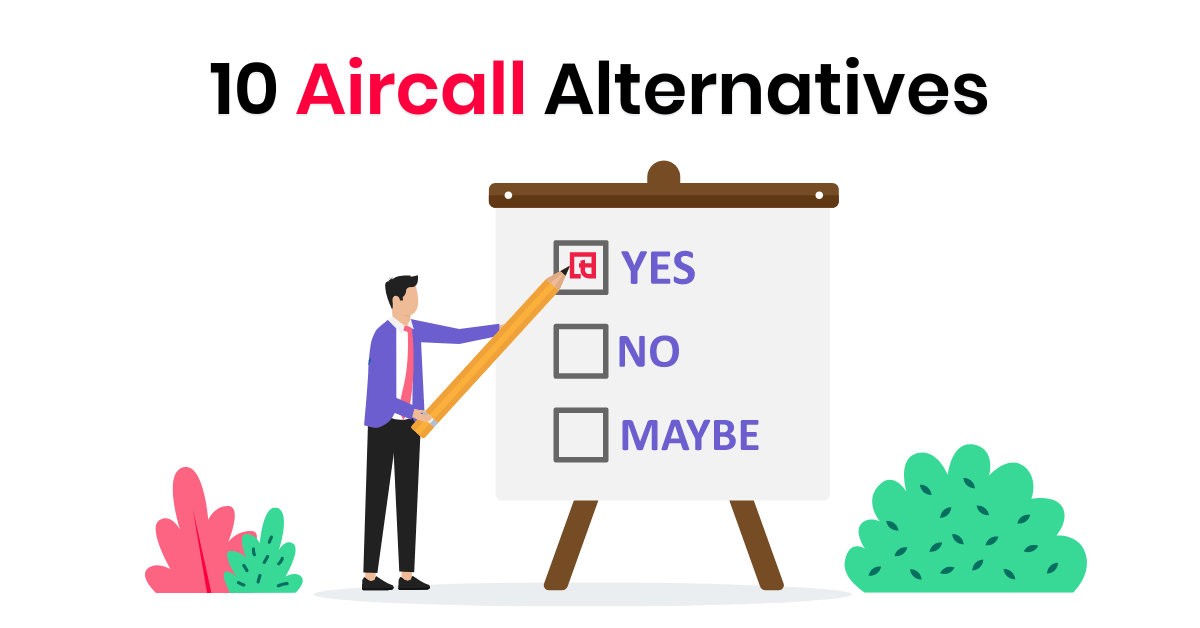42% of U.S. customers say that they prefer phone calls to handle customer service problems. That is why nowadays companies tend to understand the importance of time-saving software that not only favors their employees and their work but also saves resources. Businesses are strictly oriented toward improving their customer experience and finding new solutions to increase their productivity.
That is also the reason why according to Blueface 61% of businesses are cutting down their traditional phone lines. Moreover, CISCO states that small businesses have improved their productivity by 77% by using VoIP features. But what is VoIP and is it useful for any company? Would it be beneficial for yours’?
What is VoIP?
Simply said, VoIP is a technology that transfers voice and video over the internet. It is an affordable alternative to traditional phone lines that allows you to use any possible device (laptop, mobile phone, or even analog phone) to contact any regular user.
Not only that, but VoIP features allow you to receive voice and text messages to your inbox and help companies by displaying useful insight analytics. In fact, VoIP is a useful solution not only for businesses but also for their employees. According to Spectrumvoip, 67% of employees find it better to handle phone calls with VoIP systems. However, VoIP also contains data to track agent performance and customer satisfaction.
When talking about customer satisfaction, we cannot fail to note CRM software and its advantages of being able to personalize and collect customer insights, plus tracking the relationship between the client and the company.
How CRM could impact your business?
CRM (Customer Relationship Management) software gathers interactions (emails, calls, messages) between your customers, sales reps, team members, etc. It is an application/service that is mostly used by the sales team since it sorts, analyzes, and prioritizes the opportunities that are most likely to close. However, CRM could also be beneficial for both customer service and the marketing team. Moreover, collaborating with each other helps companies share insights, issues and improve purchases.
What is more, when the technology is implemented into the company, it’s used around 80% by sales teams, 46% by marketing, and 45% by customer services (Capterra). You may wonder if CRM software is the right solution for your business whether you own a small or large company. Well, statistics show that 91% of companies with 10 or more employees use a CRM. Another advantage is that CRM allows marketers and sales reps to personalize their communication with clients. Sounds good, right?! What about integrating CRM with VoIP?
VoIP with CRM integration. How does it work?
When the two systems come together, the benefits become enormous. It can bring customer communication to a whole different level. VoIP with CRM helps you to collect real-time call data. What is more, with the integration you would be able to easily organize all of the information for each client, anytime you need. VoIP with CRM also contains measurements of the effectiveness of your efforts.
For example, if you want to boost a similar type of conversation VoIP with CRM integration could not only record your call and attach it to the customer contact profile, but it could also display the number of calls, the time consumed for each call, and most importantly the device that the customer is using and its usual time of calling. These statistics and files could definitely improve the customer experience. The metrics also have information regarding average handle time and first contact resolution. However, since VoIP with CRM is so beneficial for businesses what could go wrong?

The Mistakes the companies made when integrating CRM with VoIP
Connection issue
I am aware of the fact that this seems strange, right? What could go wrong with the internet connection? Well, the first thing you need to know when using this kind of technology is that it needs its specifications. Yes, the speed of the internet may cause problems, however, it is not something that couldn’t be fixed about latency and jitter. What needs to be done to prevent these kinds of problems is using specialized VoIP routers or ethernet cables (CAT-5e or CAT-6e) used to be operated at a high speed.
Selecting the wrong type of CRM
Behind every successful business stands the right kind of action at the right time. Choosing to use CRM may seem like an easy solution to all of your problems, but that comes with deciding which of the three types of CRM best suits your business. Collaborative, optional, and analytical are the options you can choose from. For example, if you own a big company and one of the main internal problems is regarding communication between the teams (sales reps, marketing, and customer service), then collaborative CRM could be of great use!
This type of CRM ensures that all of the departments have the same up-to-date customer data and saves customers from having the same dreadful feeling of repeating themselves each time when they talk with a different person from the team. The optional type provides automation features used for more creative processes. It supplies the user with customer journey information that starts with the basics from the website interaction up to customer behavior and sales pipelines. Last but not least, the analytical CRM helps you define the most common problems their customers are facing, the most successful steps leading to sales, and valuable insight into customer behavior.

Yes, these are all external problems that your company could face if not making the right decision. But what if the departments are not using the systems to their full potential? There are a number of features and mistakes that the employees make that may result in a very low percentage of productivity and conversion. However, it is your responsibility to apply the right amount of features that the system offers. Despite that, here are some of the most common mistakes that you should look for.
Not Saving Voice Recording Transcripts
This is something that your business would gain the most if you decide to use it. Making transcripts of each call or video recording the useful information is a must. Although it could be difficult to implement by the developers team, it gives huge prospects for future features that could profit later. What is more, by using recording transcripts, agents can choose out of the most essential information to be transcripted depending on their needs and goals.

Lacking a System to Send Useful Messages after Call
Many companies tend to forget how important it is for the customer to receive follow-up messages based on their meeting/call. As already said, having transcripts could only benefit your business and may result in increasing the conversion rate and customer satisfaction. Call summary is not only useful for customers, but also for agents in order to straighten the next steps and easily catch errors if any misunderstanding occurs. This also shows an authentic experience and how valuable they are for your business.
Agents Manually Accessing User Data
Another feature that could be essential for your team is to automatically show the necessary information in an organized manner for each customer. CRM with VoIP’s biggest advantage is the time-saving efficiency it provides to its consumers. This is why not having this feature is straight-up illogical and beats the purpose of the integration. One of the best features that the integration offers is showing all of the important information when a customer is calling. This feature not only saves time for your agent but also prepares them professionally for the client and their problem.

Not Collecting Relevant Data
A usual mistake when integrating CRM with VoIP occurs when, for example, call centers do not utilize the important information they gather from each client. This may result in poorly personalized service. Not collecting the most important data in a systematic order would be difficult to analyze and find useful patterns (if some) of the information is missing. This is the reason why before using CRM it needs to be pointed out the most essential information that each customer should contain.
No System to Update New Data
Another crucial mistake that companies make when integrating CRM with VoIP is not adding the feature to add new information about the user. When interacting with companies, agents tend to get to know each customer more and more. The information that they gather with time could be essential to improve your insight of each customer and get better results. New information could be easily added and updated through each interaction with the user.

[Bonus]: Expert Insights

Isaac Ho, Director of Marketing at The Workflow Academy
Using laptop built-in microphone & speaker combo
Different computers provide varying qualities of sound, both in terms of speakers and microphones. Poor audio quality can cause miscommunication and reduces the effectiveness of calls, both of which can lead to unhappy customers and clients.
Solution: Purchase dedicated headphones with a built-in microphone, and make sure to test them out after integration. If possible, ensure that the VoIP application is using the headphone and not the computer’s audio hardware combo.
Having calls in noise-prone rooms/locations
Not all VoIP applications provide noise cancellation, and even that can only go so far if you’re taking calls next to loud appliances like a washing machine. The last thing customers need is to be constantly distracted by a loud sound.
Solution: Make sure that VoIP calls are taken in quiet locations, preferably isolated from other people.
Using Wi-fi to connect to the internet whilst conducting VoIP calls
Some computers only used 2.4 GHz Wifi bands, and that can sometimes lead to slower connection speeds. And with slower connection speed comes latency with VoIP calls, compromising the call quality for customers.
Solution: Ideally, connecting the computer to the network router via an ethernet cable would provide the most stable internet connection, but utilizing a 5 GHz capable Wifi Router and the computer will also provide a boost in call stability.

Matt Koopmans, Founder and Director of Aurelian Group
- Voice is much larger than CRM – look at other touch points (for example, Accounts Receivable, Technical Support) – does the integration stop at CRM? Can you transfer?
- Quality of call – where is the data center, what is the lag/latency in the voice conversation?
- Be very careful with IVR or dial-pad menus. It frustrates clients to no end when they have to wade through complex menu structures, or when the voice response system cannot pick up their accent. Where possible use number recognition allocation.
- Hardware integration – such as deskphones – is not a luxury. Softphones share resources with other processes running on your desktop. A dedicated SIP device is 100% allocated to the call. Less is more.
- What is the mobile strategy for voice?
- Unified availability queue – if you are in a meeting, will the queuing system ring your phone, go to VM, or to the next in queue? What triggers the choice (i.e. queued call versus direct dial)
CRM is but one application in the business information chain. Voice is but one entry point into it. The biggest mistake that is made is to consider one or both of these as an isolated stream – they are not. Communication is multi-channel, multi-discipline.

Florian B. Stegmann, Founder & CEO of Digital Zolutions
If you’re looking at investing in a new cloud phone system to integrate with a CRM, you’ll be aware that the choice of provider is a critical strategic decision for your enterprise. While enabling a cloud-based system is nowhere near as disruptive and expensive as installing new physical lines and endpoints in your office, every change brings costs to consider — and you certainly don’t want to do it more often than you need to.
So, it’s crucial to choose once and carefully — avoid the typical mistakes many businesses make in assessing a cloud phone provider. Here are some common pitfalls you can be sure to avoid when it’s time for your decision:
Assuming that all the VoIP Phones are the same
When assessing an unfamiliar market, it’d be easy to conclude that many options are pretty much the same — a mistake that could cost you, directly and indirectly, is particularly important regarding sound quality.
For example, some telecom solutions are based on WebRTC technology, the latest VoIP solution, and use the OPUS codec for optimal call quality. This is essential because back when VoIP was new, there was a certain amount of quality tolerance for new technology, in much the same way as there was for early mobile calling — which used very compressed bandwidth and signal. No one cared if you sounded like you were using a helicopter walkie-talkie. You could always switch back to the landline if it were too choppy.
Today’s expectations are different, and the sound quality of your business communications speaks volumes. Often it will be the first impression, increasing our socially-distanced normality. When VoIP replaces your old-style phone network, you’ll depend on how it sounds. This should not be a problem, and you need to choose well.
So, you’ll want to study reviews and testimonials and try contacting providers themselves by phone to get a sense of the quality of the experience. Few VOIP providers will work with your company’s network manager to put QoS (flow prioritization) in place, ensuring your internet connection prioritizes voice traffic. It minimizes any possibility of packet loss or interference.
Wrong VOIP Systems lead to Bad Customer Experience
With VoIP-CRM integration, sales and support agents can stay in touch with customers in real-time. CRM integration directs agents to the incoming caller’s profile. With inefficient phone systems, it would be difficult for the Customer Service team if they can’t focus while talking to the customer rather than searching for information on hold.
The right VOIP system saves agents time and allows them to focus on talking to the customers rather than searching for caller data. In addition, VoIP integration with CRM lets support agents see a customer’s past support tickets and troubleshooting history. This reduces customer wait times and increases customer satisfaction.
Unavailability of Features in the VOIP System
Direct Calling with CRM should be one, so ideally, we need to find a VoIP integration that lets you make direct calls from CRM. Also, you will be able to get rid of time-consuming tasks, which means agents have more time in hand to make more calls.
So, when you synchronize your VoIP phone system with your CRM, you might need several features and functionalities, such as Click Text Icons, SMS automation & Bulk SMS should be a part of the system along with the dialing features.
CRM Integration also allows you to keep an eye on the call analytics, from where you can view your metrics and KPIs of outgoing and incoming calls. You can also keep track of things such as call diverts, time spent on calls, calls received, and more.
So we must carefully analyze the VOIP system, which contains the features necessary to run the operations smoothly.
Picking the wrong pricing model
Many cloud phone system providers offer complex and intricate tariff systems, which are difficult to find your way through, particularly when estimating call volumes in advance.
Many businesses will get burned with unexpected overage fees when they cannot predict where and when colleagues will work during these uncertain times — when your customers may need more extensive phone contact for reassurance. Other businesses may need to scale down temporarily and take advantage of furlough schemes to ensure long-term continuity, so if committed to the wrong monthly usage volumes, it’d be easy to end up paying too much for services you don’t end up using anyway,
Analyze and find simple and transparent plans that make it easy to budget and plan where your accountants will love them as much as your users and communications managers. You can scale up and down quickly based on a simple per-user-per-month subscription basis. Unlimited calls mean no worrying about renewal dates and exorbitant surcharges for going off-plan and over your allocation.
Instead, you decide whether you need the advanced analytics and integration features of our power user plan or whether the intelligent plan works for you (perhaps by experiencing the full functionality through a free trial), then away you go.
Not anticipating your use cases correctly
What do you want to use your phone system for? If that sounds too obvious to be worthy of consideration, I would need to give this important question a bit more thought.
For example, will most of your calls be incoming for customers and others to contact you in response to advertisements and similar calls to action? In which case, you’ll want to prioritize features like a flexible and responsive IVR system to ensure a prompt response from the person in your organization who can best meet that need effectively.
So, before you commit to a provider, could you be sure to have done a thorough analysis of exactly what your needs are now and also what you anticipate them to be in the future. Of course, you can always upgrade within a product, but switching from one provider to another can be difficult. You may find that some lower-cost providers with fewer features or less commitment to continual innovation will hold on to you by means such as long, inflexible contract times.
It’s worth exploring why they feel the need to do that and opting in preference for a system that can do everything your business needs, both now and in the future; otherwise, you’ll end up paying more for third-party integrations, which may or may not work in the way you want them to do.
Not choosing a system that can grow with you
A phone system that grows with you, and lets you add new features as you expand, offers maximum power and flexibility — whether you’re a freelancer with big ideas or a large corporation expanding into new territories.
Remember, with a VoIP system, it doesn’t matter where you, or your colleagues, do their work — so opening new offices, or equipping new team members to work from home or in a fully mobile way, is no problem at all. No cabling, hardware, or engineers need site access and no downtime. You can add and remove people at the touch of a button. They can access the whole system via any device you or they provide — even switching devices mid-call, for total location independence and flexibility.
And suppose your plans might include adding new marketing and database backends in the future as you grow. In that case, you’ll also want the power to connect to new tools with flexible integrations and ensure your work remains on track as you expand with excellent data and analytics. At some point, for example, you will probably want the Power-user options to take advantage of the more sophisticated functionality of the upgraded systems on offer — but without losing any of your numbers, extensions, data, or routing.
Overlooking compliance regulations
Another costly mistake business owners make is not ensuring that the cloud telephony service they choose adheres to applicable regulations. The issue of security has become one of the foremost concerns for businesses; hence it’s crucial to ensure you’re following all applicable laws.
Many businesses have to face penalties and costly fines due to improper management and the use of data on the phone system they choose. Unfortunately, this often happens due to the lack of your concern regarding compliance regulation of the cloud telephony system.
The business owner must ask the provider about security compliance to avoid this. Don’t hesitate to ask how the data will be stored and how they will be kept safe from a potential attack.
Backup Process
Unlike traditional systems, VoIP phones have a high chance of facing connectivity issues. It is the last thing that any business wants that their system is down for a more extended period. If you run your own business, your biggest nightmare is probably having your system go down for an extended period.
For instance, you got a service provider at a low price, but they do not have any facility to get the phone system back up as soon as possible if something goes wrong. You might cost a lot of money if your service provider can’t deal with such situations.
That’s why it’s crucial to choose a VoIP provider with a solid backup plan in the event of an unforeseen power outage or another issue.
Not Choosing A Provider That Offers Support
Customer service is essential, especially in our new business world of remote and flexible working. It is one of the prime points of contact between your business and VoIP service provider.
You need to remember when you are investing in a new VoIP system that you are also investing in the company itself too.
Ensure that the organization you choose has strong and knowledgeable customer support which is always available or at least within your working hours.

Melanie Ayoola, Executive Director, Tranter IT & IoT Africa
VoIP CRM integration enables VoIP service providers to connect a CRM account with their business phone system. For businesses, VoIP integration with CRM opens up a whole new world of communication. It allows you to synchronize different tools with the phone system; this reduces manual work.
Not integrating your CRM with marketing tools.
Many companies mistakenly think of CRM as a software tool belonging to the sales department. But by integrating CRM with VoIP in your marketing tools—in consultation with the marketing department—your sales representatives will receive more qualified leads to pursue.
To fully enjoy the benefits of CRM, VoIP should be fully integrated with your Marketing Automation Platform (MAP) and other marketing tools. 80% of marketing automation users see an increase in leads, while 77% see an increase in conversions when VoIP is adopted. Integrating CRM with VoIP marketing tools doesn’t just provide sales representatives with a source for leads, but also offers valuable information about those leads—thereby saving time.
Not setting and enforcing procedures for CRM usage.
Sales representatives can’t reap the benefits of CRM integrated with VoIP if they don’t actually use the software on a regular basis to communicate effectively. Many representatives are resistant to using CRM and will need to be guided in proper CRM usage.
Create standardized procedures for how representatives should enter data into CRM, train your representatives, and then actually enforce them. To effectively encourage CRM usage, make it a policy that sales activity not recorded in the CRM doesn’t count for commissions or performance evaluation. You can also run sales contests to encourage best practices and avoid CRM mistakes.
Not knowing the difference between Leads, Contacts, and Opportunities.
Terminology is critical for successful CRM usage. Salesforce and other CRM applications differentiate between leads, contacts, and opportunities. Sometimes these definitions don’t coincide with the colloquial terms utilized in your department and these can be curbed with the use of VoIP. In a CRM program these distinctions aren’t merely semantic but reflect relevant information about the state of the sales cycle. Failure to understand terminology results in a confused CRM system that is less capable of accurately forecasting sales.
All CRM users should understand these distinctions, how and why to convert leads into opportunities, and know how to add additional contacts to an account.
When you first import data into your CRM, import them as leads. A lot of your contacts are not yet opportunities and should not be treated as such.
Including too many required fields in your CRM.
While CRM systems are capable of retaining a great deal of information about individual leads, don’t require too many data fields. When users have to input a lot of data at once, they are less likely to utilize the CRM. Users should only have to enter in a bare minimum of information about a lead when they first enter it into the system. More information can always be added at a later time.
Summary
When choosing a VoIP system, you need to think about the future. The possibility of both deduction and expansion of your team should be considered when purchasing a VoIP system. You need to invest in a scalable system that will easily allow you to add and remove users and features as and when needed. Not only this, but it needs to be affordable to make these adjustments and easy to do so with no disruption.
Your business could only gain by integrating CRM with VoIP. The importance of using the two systems combined together is in using them at their full compatibility. Furthermore, being aware of the most common mistakes is an advantage that your competitors may not be aware of.

Kamelia Kalcheva
Content Marketing Manager at Squaretalk





